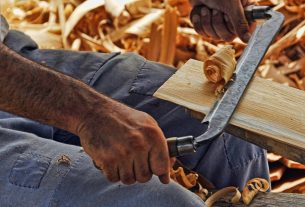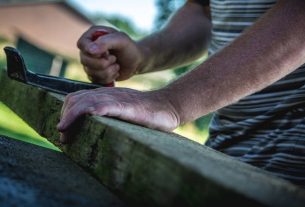Square-ended butt joints
It is possible to make flat frames and simple box structures utilizing square-cut corner joints. Use sawn wood for rough carpentry, but plane the wood square beforehand for good-quality cabinet work. Since glue alone is rarely adequate to make a sturdy butt join, hold the parts together with fine nails or glued blocks of wood.
Mitered butt joint
The classic joint for picture frames, the mitered butt joint makes a neat right-angle corner without visible end grain. Cutting wood at 45 degrees produces a relatively large surface area of weight frames, just add glue and set the join in a miter clamp for a while.
Edge-to-edge butt joint
Lumber selection is important as good edge-to-edge joints when making wide panels from solid wood. To make sure the panel will remain flat; try to use quarter-sawn wood – that is, with the end-grain growth rings running perpendicular to the face side of each board. If that is not possible, arrange them so the direction of ring growth alternates from one board to the next. Also try to make sure the surface grain on the boards runs in the same direction, to facilitate the final cleaning up of the panel with a plane. Before you get to work, number each board and mark the face sides.
Tongue and groove joint
Use a combination plane to cut a tongue-and-groove joint by hand. This kind of plane is similar to a standard plow plane, but comes with a wider range of cutters, including one designed to shape a tongue on the edge of a workpiece. Cut the tongue first, then change the cutter and plane a matching groove.
Doweled frame joints
Frames made with doweled butt joints are surprisingly strong. Nowadays, most factory-made furniture incorporates dowel joints even for chair rails, which must be capable of resisting prolonged and considerable strain. In most cases, two dowels per joint are sufficient. Place them a minimum of ¼ inch from both edges of the rail.
Edge-to-edge dowel joint
When constructing a wide solid-wood panel, you can make a particularly strong join between boards by inserting a dowel every 9 to 12 inches.
Carcass butt joints
When constructing a carcass with butt joints that are reinforced with multiple dowels, it pays to buy extra-long slide rods and additional drill bit guides for the doweling jig. A doweling jig is required for many of the doweled joints. This can be an expensive piece of machinery and if you are not going to use it very often, it might be worth looking into renting one or borrowing one from someone.
Corner bridle joint
A corner bridle joint is adequate for relatively lightweight frames, provided they are not subjected to sideways pressure, which tends to force bridle joints out of square. The strength of the bridle is improved considerably if you insert two dowels through the side of the joint after the glue has set.
Mitered bridle joint
The mitered bridle is cut in a similar fashion as the conventional corner joint, but is a more attractive alternative for framing, because end grain appears on one edge only.
T-bridle joint
The T-bridle joint serves as an intermediate support for a frame and with modifications, is sometimes used to join a table leg to the underframe when a long rail requires support. Unlike the corner bridle, which is relatively weak under sideways pressure, the t-bridle is similar in strength to the mortise-and-tenon joint.
Lap joint
A basic lap joint is only marginally stronger than a straightforward butt joint, but it is an improvement in appearance since most of the end grain is concealed. As a result, it is sometimes used as a relatively simple way of connecting a drawer front to drawer sides.
Through mortise and tenon joint
The through joint, where the tenon passes right thought the leg, is used a great deal for construction frames of all kinds. With the end grain showing, possibly with wooden wedges used to spread the tenon, it is an attractive businesslike joint. Always cut the mortise first, since it is easier to make the tenon fit exactly than the other way around.





